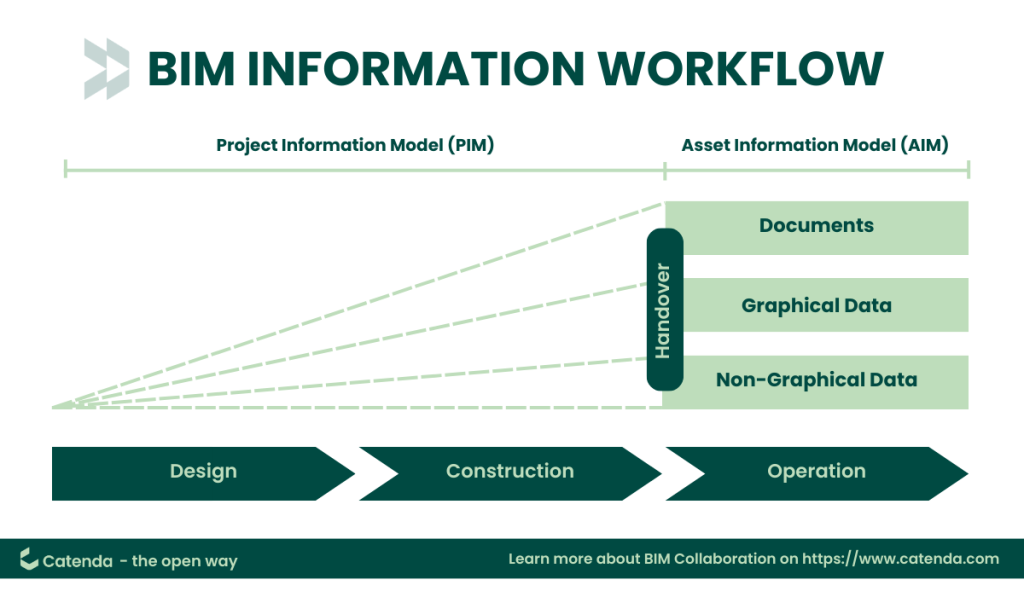Based on the PASS 1192, ISO 19650 was introduced to consolidate the BIM (Building Information Modeling) Level 2 initiatives. This BIM level highlights the Project Information Model (PIM) and Asset Information Model (AIM) as parts of adjoined phases of a Common Data Environment (CDE).

What is the Asset Information Model according to ISO 19650?
The Asset Information Model or AIM can be defined as a unique collated set of necessary information gathered from different sources to facilitate asset management and decision making.
When a construction project is completed, some pieces of information are transferred from the PIM (Project Information Model) to the AIM (Asset Information Model). In this transitional period, all the data scattered in the business is identified, validated and combined into one single source.
What is the difference between AIM (Asset Information Model) and PIM (Project Information Model)?
According to the Employer’s Information Requirements (EIR), while the PIM (Project Information Model) is elaborated during the design and construction phase, the AIM (Asset Information Model) is developed at a later stage, within the operational phase.
What information is included in the AIM?
There are several kinds of information that can be found in the AIM.
- Information on the original design intent.
- 3D models and other related ones.
- Information about the asset owner, ownership details, surveys, rights, conditions & restrictions, jobs that have been underway, operational performance attributes, etc.
Why is the Asset Information Model important to a BIM project in construction?
Promotes collaboration and decision making throughout the asset lifecycle
Throughout the whole lifecycle of a physical asset, the load of exchanged data and information is extremely huge and complex, not to mention that there are a lot of participants involved at different stages. Therefore, it is absolutely necessary to have a place where all the data of this asset is comprehensive, well-arranged, updated and accessible to related individuals and parties.
Considering what is mentioned above, the AIM seems to be such a good solution. The AIM acts as a single source of information and a shared space that everyone in the project can access and collaborate with other members. Supported by a pool of rich and validated data, project participants can make better informed decisions about their assets, the ongoing management of the assets in the operational phase and maintenance work as well.
Facilitates the maintenance management at the later stages of the project
There might be a lot of maintenance activities such as performance evaluations, repairs, replacement, renovation, regulatory changes and changes of ownership during the later stages of a project. Hence, the AIM plays an important role in providing essential information to make these activities run smoothly and efficiently.
What are the requirements to keep in mind when developing the AIM strategy?
The integrity of the AIM must be guaranteed
The AIM is managed within a CDE (Common Data Environment). To ensure its integrity, authenticity, and accuracy under the influence of PASS 1192, an Information Management Process (IMP) should be set up. A data manager, or data administrator and data technician in some cases, will be involved in the process and take charge of validating and approving the data transformed to the shared space of the CDE.
The AIM should be updated on a regular basis and the frequency depends on the importance of required information.
The way to collect and validate data and information should be clarified from the beginning
It is important to come to an agreement on what kinds of format is used during the project, who is in charge of reviewing the database in terms of its integrity and how this process should be implemented. This step is necessary to ensure that the input is clean and qualified for the next stages in the BIM project.
A back-up strategy is required to ensure the smooth running of the project
As the AIM acts as a single point of data, the case would be horrible if the data space crashed and there was no back-up plan for the system to operate as normal. Hence, it is unquestionable that each BIM project needs a plan for the worst case scenario, which includes a disaster recovery strategy and an action plan within a specific timeframe.



